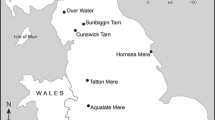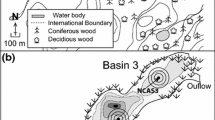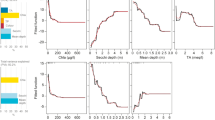Abstract
Submerged macrophyte abundance strongly influences aquatic ecosystems. Because of a lack of monitoring data, however, the long-term dynamics of such aquatic plants are poorly understood. Increasingly, paleolimnologists use changes in subfossil algae and invertebrates to infer past submerged macrophyte dynamics and assess how human activities have altered this important primary producer component of aquatic ecosystems. We evaluated the sensitivity of subfossil diatom and chironomid assemblages to historically documented changes in macrophyte abundance in Chenango Lake, New York, USA, where macrophyte cover has been monitored since 1978. We also tested the ability of a semi-quantitative diatom-based macrophyte-abundance inference model to detect the pronounced macrophyte decline that was observed between 1993 and 2001. Diatoms responded to the recent loss of macrophytes, with a decline in the relative abundance of macrophyte-associated taxa. Estimates of macrophyte abundance fluctuated according to the diatom-based inference model. Chironomid changes were coherent with the diatom-inferred macrophyte zones. The largest shifts in subfossil assemblages occurred before the start of the monitoring record and coincided with construction of a ~4.3-m-high dam on the lake, which substantially expanded the littoral habitat. Even in heavily managed systems, large reductions in macrophyte abundance can be detected with paleolimnological approaches.




Similar content being viewed by others
References
Appleby PG (2002) Chronostratigraphic techniques in recent sediments. In: Smol JP, Last W, Birks HJB (eds) Tracking environmental change using lake sediments, volume 1: basin analysis, coring, and chronological techniques. Kluwer Academic Publishers, Dordrecht, pp 171–203
Battarbee RW, Carvalho L, Jones VJ, Flower RJ, Cameron NG, Bennion H, Juggins S (2001) Diatoms. In: Smol JP, Last W, Birks HJB (eds) Tracking environmental change using lake sediments, volume 1: basin analysis, coring, and chronological techniques. Kluwer Academic Publishers, Dordrecht, pp 155–202
Birks HH (2000) Aquatic macrophyte vegetation development in Kråkenes Lake, western Norway, during the late-glacial and early Holocene. J Paleolimnol 23:7–19
Brodersen KP, Odgaard BV, Vestergaard O, Anderson NJ (2001) Chironomid stratigraphy in the shallow and eutrophic Lake Sobygaard, Denmark: chironomid macrophyte co-occurrence. Freshw Biol 46:253–267
Carpenter SR, Lodge DM (1989) Effects of submersed macrophytes on ecosystem processes. Aquat Bot 26:341–370
Carter CC, Hestand RS (1975) The effects of selected herbicides on phytoplankton and sulfur bacteria populations. J Aquat Plant Manag 15:47–56
Cattaneo A, Kalff J (1978) Seasonal changes in the epiphyte community of natural and artificial macrophytes in Lake Memphremagog (Que. & Vt.). Hydrobiologia 60:135–144
Cumming BF, Wilson SE, Hall RI, Smol JP (1995) Diatoms from British Columbia (Canada) lakes and their relationship to salinity, nutrients, and other limnological variables. Bibliotheca Diatomologica. J. Cramer, Berlin
Davidson TA, Sayer CD, Bennion H, David C, Rose N, Wade M (2005) A 250 year comparison of historical, macrofossil and pollen records of aquatic plants in a s hallow lake. Freshw Biol 50:1671–1686
Davidson TA, Sayer CD, Perrow M, Jeppesen E (2010a) The simultaneous inference of zooplanktivorous fish and macrophyte density from sub-fossil cladoceran assemblages: a multivariate regression tree approach. Freshw Biol 55:546–564
Davidson TA, Sayer CD, Langdon PG, Burgess A, Jackson M (2010b) Inferring past zooplanktivorous fish and macrophyte density in a shallow lake: application of a new regression tree model. Freshw Biol 55:584–599
Davidson TA, Bennion H, Sayer CD, Jeppesen E, Clarke GH, Morley D, Odgaard B, Rasmusen P, Rawcliffe R, Salgado J, Amsinck SL (2011) The role of cladocerans in tracking long-term change in shallow lake ecosystem structure and function. Hydrobiologia 676:299–315
Davis FW (1985) Historical changes in submerged macrophyte communities of Upper Chesapeake Bay. Ecology 66:981–993
Effler SW, Litten S, Field SD, Tong-Ngork T, Hale F, Meyer M, Quirk M (1980) Whole lake responses to low level copper sulfate treatment. Water Res 14:1489–1499
Egertson CJ, Kopaska JA, Downing JA (2004) A century of change in macrophyte abundance and composition in response to agricultural eutrophication. Hydrobiologia 524:145–156
Elser JJ, Luecke C, Brett MT, Goldman CR (1995) Effects of food web compensation after manipulation of rainbow trout in an oligotrophic lake. Ecology 76:52–69
Fallu MA, Allaire N, Pienitz R (2000) Freshwater diatoms from northern Québec and Labrador (Canada): species–environment relations in lakes of boreal forest, forest-tundra and tundra regions. Bibliotheca Diatomologica Vol. 45. J. Cramer, Berlin
Glew JR (1989) A new trigger mechanism for sediment samplers. J Paleolimnol 2:241–243
Greffard M-H, Saulnier-Talbot E, Gregory-Eaves I (2011) A comparative analysis of fine versus coarse taxonomic resolution in benthic chironomid community analyses. Ecol Indic 11:1541–1551
Greffard M-H, Saulnier-Talbot É, Gregory-Eaves I (2012) Subfossil chironomids are significant indicators of turbidity in shallow lakes of northeastern USA. J Paleolimnol 47:561–581
Hallingse ME, Phlips EJ (1996) Effects of Cutrine-Plus and Side-Kick II on the growth of algae and cyanobacteria. J Aquat Plant Manag 34:39–40
Heiri O, Lotter AF, Lemcke G (2001) Loss on ignition as a method for estimating organic and carbonate content in sediments: reproducibility and comparability of results. J Paleolimnol 25:101–110
Heiri O, Ekrem T, Willassen E (2004) Larval head capsules of European Micropsectra, Paratanytarsus and Tanytarsus (Diptera: Chironomidae: Tanytarsini) 50 pp Online article, Version 1.0: http://stage.bio.uu.nl/palaeo/Chironomids/Tanytarsini/Heiri,%20Ekrem,%20Willassen%202004%20v.%201.0.pdf. Accessed 2011-08-08
Jeppesen E, Lauridsen TL, Kairesalo T, and Perrow MR (1998) Impact of submersed macrophytes on fish-zooplankton interactions in lakes. In: Jeppesen E, Søndergaard M, Søndergaard M, Christoffersen K (eds) The structuring role of submerged macrophytes in Lakes. Springer, New York, USA, pp 91–114
Jones CG, Lawton JH, Shachak M (1994) Organisms as ecosystem engineers. Oikos 69:373–386
Juggins S (2003) C2 User Guide. Software for ecological and paleoecological data analysis and visualization. University of Newcastle, Newcastle upon Tyne, UK, p 69
Juggins S (2012) Rioja: analysis of Quaternary Science Data, R package version 0.7-3. http://cran.r-project.org/package=rioja
Krammer K, Lange-Bertalot H (2004) Bacillariophyceae 4. Teil: Achnanthaceae, Kritische Ergänzungen zu Achnanthes s.l., Navicula s.str., Gomphonema, Gesamtliteraturverzeichnis Teil 1-4. In: Ettl H, Gärtner G, Gerloff J, Heynig H, Mollenhauer D (eds) Süßwasserflora von Mitteleuropa, Bd. 2/4. Spektrum Akademischer Verlag, Berlin, p 468
Krammer K, Lange-Bertalot H (2007) Bacillariophyceae Teil 2: Bacillariaceae, Epithemiaceae, Surirellaceae. In: Ettl H, Ettl H, Gerloff J, Heynig H, Mollenhauer D (eds) Süßwasserflora von Mitteleuropa, Bd. 2/1. Spektrum Akademischer Verlag, Berlin, p 612
Krammer K, Lange-Bertalot H (2008a) Bacillariophyceae Teil 1: Naviculaceae, A: Text; B: Tafeln. In: Ettl H, Gerloff J, Heynig H, Mollenhauer D (eds) Süßwasserflora von Mitteleuropa, Bd. 2/1. Spektrum Akademischer Verlag, Berlin, p 876
Krammer K, Lange-Bertalot H (2008b) Bacillariophyceae Teil 3: Centrales, Fragilariaceae, Eunotiaceae. In: Ettl H, Gerloff J, Heynig H, Mollenhauer D (eds) Süßwasserflora von Mitteleuropa, Bd. 2/3. Spektrum Akademischer Verlag, Berlin, p 600
Langdon PG, Ruiz Z, Wynne S, Sayer CD, Davidson TA (2010) Ecological influences in larval chironomid communities in shallow lakes: implications for palaeolimnological interpretations. Freshw Biol 55:531–545
Legendre P, Gallagher ED (2001) Ecologically meaningful transformations for ordination of species data. Oecologia 129:271–280
Oksanen J, Blanchet FG, Kindt R, Legendre P, Minchin PR, O’Hara RB, Simpson GL, Solymos P, Stevens MHH, Wagner H (2011) Vegan: Community Ecology Package. R package version 2.0-2. http://CRAN.R-project.org/package=vegan
Pinder LCV (1986) Biology of freshwater Chironomidae. Ann Rev Entomol 31:1–23
Pinder LCV, Reiss F (1983) The larvae of Chironomidae (Diptera: Chironomidae) of the Holarctic region—keys and diagnoses. Ent Scand Suppl 19:293–435
R Development Core Team (2012) R: A language and environment for statistical computing. R Foundation for Statistical Computing, Vienna, Austria. ISBN 3-900051-07-0, URL http://www.R-project.org
Reavie ED, Smol JP (1997) Diatom-based model to infer past littoral habitat characteristics in the St. Lawrence River. J Great Lakes Res 23:339–348
Rooney N, Kalff J, Habel C (2003) The role of submerged macrophyte beds in phosphorus and sediment accumulation in Lake Memphremagog, Quebec, Canada. Limnol Oceanogr 48:1927–1937
Sayer CD (2001) Problems with the application of diatom-total phosphorus transfer functions: examples from a shallow English lake. Freshw Biol 46:742–757
Sayer CD, Burgess A, Kari K, Davidson TA, Peglar S, Yang H, Rose N (2010) Long term dynamics of submerged macrophytes and algae in a small and shallow, eutrophic lake: implications for the stability of macrophyte dominance. Freshw Biol 55:565–583
Scheffer M (2004) Ecology of shallow lakes. Kluwer Academic Publishers, Dordrecht, p 363
Titus JE (1983) Submersed macrophyte vegetation and depth distribution in Chenango Lake, New York. Bull Torrey Bot Club 110:176–183
Titus JE, Sullivan PG, Grisé D, Stephens MD (2004) Monitoring submersed vegetation in a mesotrophic lake: correlation of two spatio-temporal scales of change. Aquat Bot 79:33–50
Vermaire JC, Prairie Y, Gregory-Eaves I (2011) The influence of submerged macrophytes on sedimentary diatom assemblages. J Phycol 47:1230–1240
Walker IR (2001) Midges: Chironomidae and related Diptera. In: Smol JP, Birks HJB, Last WM (eds) Tracking environmental change using lake sediments. Volume 4: zoological indicators, developments in paleoenvironmental research. Kluwer, Dordrecht, pp 43–66
Wiederholm T (1983) Chironomidae of the Holarctic region, keys and diagnosis. Part I: Larvae. Ent Scand Suppl 19. Lund, Sweden, p 457
Zhao Y, Sayer CD, Birks HH, Hughes M, Peglar SM (2006) Spatial representation of aquatic vegetation by macrofossils and pollen in a small and shallow lake. J Paleolimnol 35:335–350
Acknowledgments
Funding for this research was provided by a Natural Sciences and Engineering Research Council (NSERC) Discovery Grant to IGE and a Fonds Québécois de la Recherche sur la Nature et les Technologies (FQRNT) Postdoctoral Fellowship to ES-T. Thank you to Erika Brown for assisting with the fieldwork. This manuscript is a contribution to the FQRNT funded Groupe de Recherche Interuniversitaire en Limnologie (GRIL).
Author information
Authors and Affiliations
Corresponding author
Electronic supplementary material
Below is the link to the electronic supplementary material.
10933_2013_9737_MOESM1_ESM.pdf
Fig. S1 Redundancy analysis (RDA) used to infer macrophyte abundance in Chenango Lake constrained by total phosphorus (TP) and whole-lake macrophyte biomass (BiomEpiV). The Chenango Lake sediment core sites are plotted passively (i.e. unconstrained by environmental variables; numbers shown give depth of sample in cm in the sediment core) whereas the surface sediments from a 41-lake training set are constrained by TP and BiomEpiV. Note that the samples from the 41-lake training set are not shown, to focus on the changes in the Chenango Lake sediment core. Multivariate regression tree (MRT) group divisions are shown by the dashed lines and group labels and the diatom-inferred decline in macrophyte abundance associated with the observed reduction in macrophyte cover in Chenango Lake is highlighted by the red arrow (PDF 41 kb)
Rights and permissions
About this article
Cite this article
Vermaire, J.C., Greffard, MH., Saulnier-Talbot, É. et al. Changes in submerged macrophyte abundance altered diatom and chironomid assemblages in a shallow lake. J Paleolimnol 50, 447–456 (2013). https://doi.org/10.1007/s10933-013-9737-3
Received:
Accepted:
Published:
Issue Date:
DOI: https://doi.org/10.1007/s10933-013-9737-3




